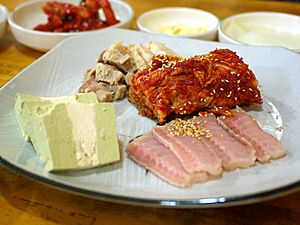Hongeo-hoe facts for kids

|
|
| Type | Hoe |
|---|---|
| Place of origin | Korea |
| Region or state | Honam |
| Main ingredients | Fermented ocellate spot skate |
| Korean name | |
| Hangul | |
|---|---|
| Hanja | |
| Revised Romanization | hong'eohoe |
| McCune–Reischauer | hongŏ-hoe |
| IPA | [hoŋ.ʌ.ɦwe̞] |
Hongeo-hoe (Korean: 홍어회; Hanja: 洪魚膾) is a special type of fermented fish dish from the Jeolla province in Korea. It is made from a fish called skate. Hongeo-hoe has a very strong and unique smell, a bit like ammonia (which is found in cleaning products). Some people describe its smell as being very powerful!
History of Hongeo-hoe
Skates, also known as hongeo, are a type of fish that have cartilage instead of bones, like sharks. These fish naturally release a substance called uric acid through their skin. When skates are left to ferment, this uric acid turns into ammonia. This ammonia helps to keep the fish from going bad and gives hongeo-hoe its famous, strong smell.
Korean fishermen discovered this natural way of preserving skate meat a long time ago, even back in the 14th century during the Goryeo dynasty. This was long before refrigerators were invented! They found that skates were the only fish that could be carried over long distances or stored for a long time without rotting, even without using salt. This made hongeo-hoe a very important food for travel and storage.
How Hongeo-hoe is Made
Originally, the skates used to make hongeo-hoe were caught near Heuksando, an island off the southwest coast of Korea. Today, many skates come from other places, like Chile, because they are less expensive. However, skates from Heuksando are still thought to be the best quality.
The way hongeo-hoe is made can be a little different depending on where it's produced. In the past, after the fish were cleaned, they were stored in compost (in cold places) or in piles of straw (in warmer places) to ferment.
Nowadays, to make sure the food is safe and always tastes the same, refrigerators are often used. One modern way involves fermenting the fish in a large refrigerator for about 15 days at a temperature of 2.5 degrees Celsius. Then, they are kept for another 15 days at an even colder temperature of 1 degree Celsius.
After the fermentation process is complete, the preserved skates are cut into small pieces. Then, they are packed into boxes and sent out to be enjoyed.
Eating Hongeo-hoe
Hongeo-hoe is usually served in small, thin slices, similar to sashimi. It is eaten raw, without any cooking.
People from the Jeolla region often say that hongeo-hoe should be eaten by itself to truly taste its unique flavor. However, it is also commonly eaten with other Korean dishes. A popular way to eat it is with bossam (boiled pork) and kimchi (spicy fermented cabbage). This combination is known as hongeo samhap. Sometimes, people also drink a Korean alcoholic beverage called makgeolli with hongeo-hoe. This drink can help to balance the strong taste of the fermented fish.

